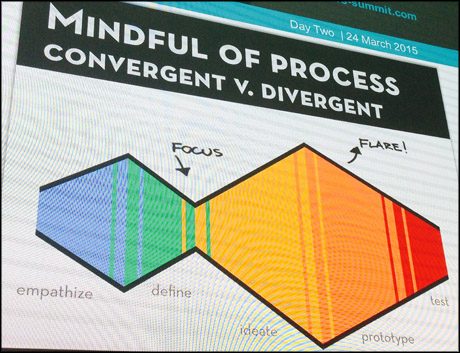
The Stanford University d.school, the Institute of Design, prides itself on believing everyone is creative, not necessarily in the artistic sense, but in the ability to think differently.
Speaking at the Digital Innovators' Summit in Berlin today, the d.school's director of fellowships Justin Ferrell shared some of the Institute's approaches to creative thinking and creative doing.
"If you want to make something unique you have to do something different," he said, and that will often come from the "radical collaboration" of combining many different perspectives in the creative process.
"If you only hang out with people who are similar to you, it's much easier personally, but in your work you're more likely to come up with incremental ideas," he said, rather than the big disruptive ideas that can make a difference.
Before joining Stanford, Ferrell spent eight years at the Washington Post, culminating in his position as director of digital, mobile and new product design.
He shared Stanford d.school's process for creative thinking, and how it could apply to newsrooms.
Empathise
In identifying problems and working towards a solution, the first step is to empathise with the person experiencing the problem directly.
In one example, Ferrell pointed to a Stanford professor who took publishers to a train station to ask how they like to receive news while commuting.
"[It's] going out to where users are and engaging with them in their life," he said.
Define
The second step is in learning from empathising to define the problem.
It may mean reframing the problem away from the original hypothesis, said Ferrell, but the ultimate aim is to decide what is important.
Ideate
When coming up with ideas Ferrell stressed how important it is to "separate the idea generation process from the idea selection".
Throwing out ideas almost as soon as they are thought of can be counter-productive, so people should look to imagine as many possibilities as may be available before moving on.
Prototype
"Prototyping is all about getting more feedback," Ferrell said.
And this first iteration of the physical product, whether software, hardware or a new storytelling process, should be quick to produce.
"Because you don't spend very much time on it you're much more open to the feedback you receive, and it doesn't cost you very much."
The aim of the prototype, he said, is to "create experiences" and gather feedback from users.
Test
A certain amount of testing can be done internally, but the valuable feedback – "the gold" – isn't gathered until a product is tested in the real world.
"You're not a used car salesman when you're testing," Ferrell joked. "If you find yourself selling too much it means your idea isn't really resonating."
The steps shouldn't be followed in a rigid structure, but the process should involve a certain amount of feedback between steps, he said.

But the inherent culture of some news outlets, especially legacy news organisations, can stand in the way of inspirational, digital change, Ferrell warned.
"To take advantage we need to design organisations in the way the internet is designed", with "multidisciplinary" and "cross-functional content teams".
At the Post, Ferrell helped teams develop the first iPad app, designed the Pulitzer Prize-winning investigative series into Dick Cheney's time as vice president, and was envovled in developing real-time fact-checking app Truth Teller.
Each involved a mixture of journalists, designers and developers to come up with creative answers.
And when given the freedom to learn, create and teach, "one team inspires the next," he said, "and ten years on you find yourself working in all the different areas that no one could have planned for".
Free daily newsletter
If you like our news and feature articles, you can sign up to receive our free daily (Mon-Fri) email newsletter (mobile friendly).
Related articles
- The twists and turns of audio storytelling with Andy Mills
- 'Tell personal stories to help explain the big issues in the news' – Q&A with mobile journalist Wytse Vellinga
- Why Quartz puts user experience at the centre of its strategy
- The evolving ecosystem for media and news
- 'Independence, integrity' key to news for millennials









